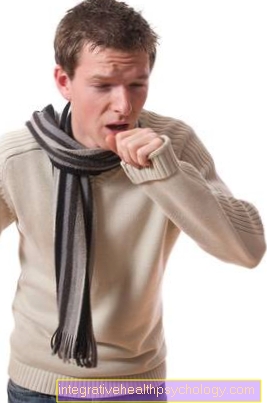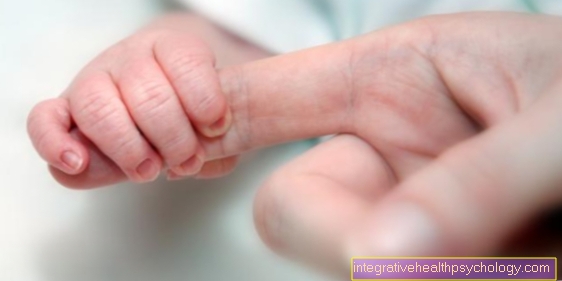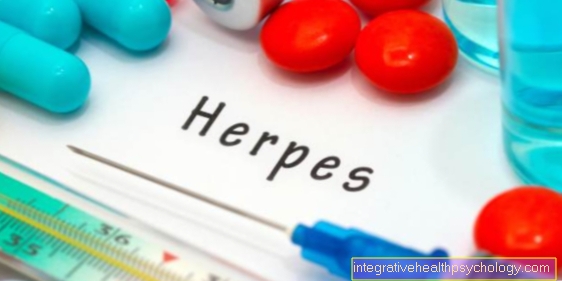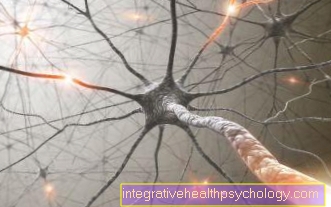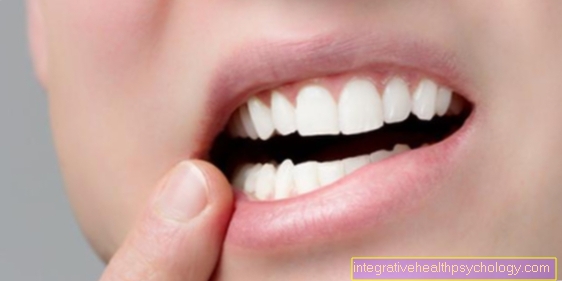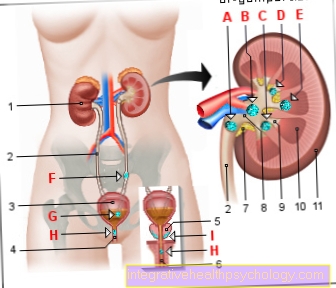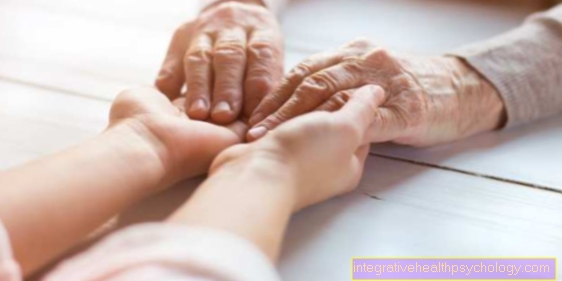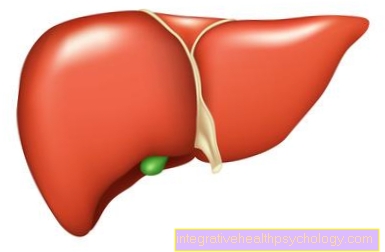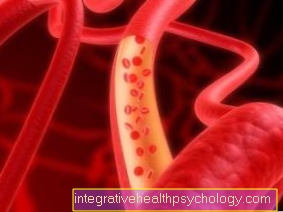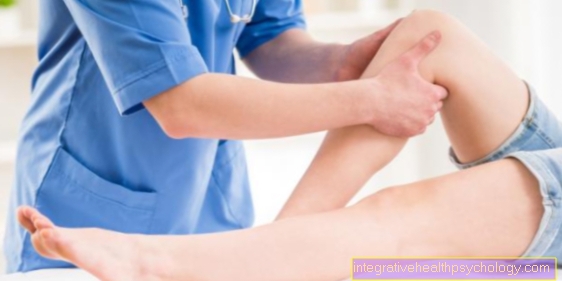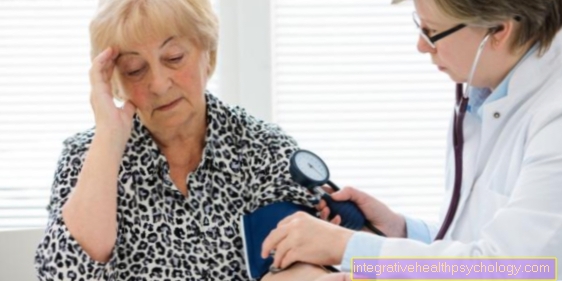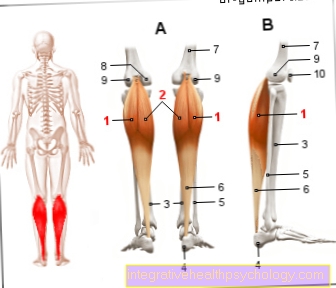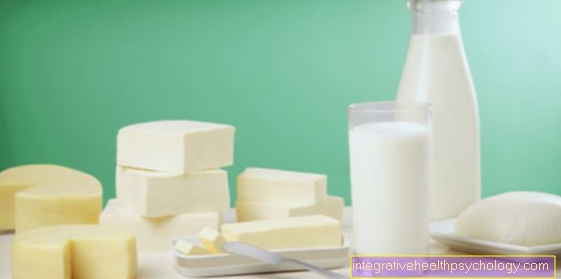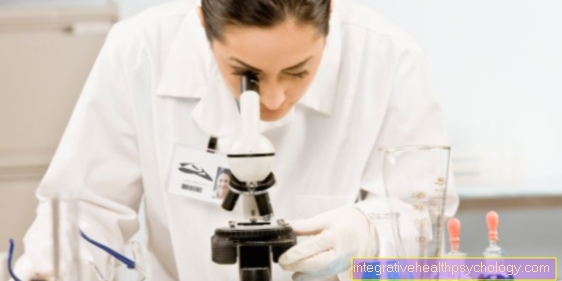Drawing in the left chest
introduction
Chest pain can be caused by several things.
In addition to the most common cause, muscular tension, more serious diseases can also be considered.
That is why you should consult your doctor if you have a pull in the left chest that lasts longer and cannot be caused by excessive physical strain.

causes
Our heart is an important organ in the left chest area, which can typically trigger pain sensations such as "pulling".
But also the lungs, as well as the lung membrane (lat .: Pleura) can cause discomfort in the left breast.
Injuries or tears in the main artery (Latin: aorta) are also often noticeable through the described symptom.
Even upper abdominal organs such as the stomach, esophagus or pancreas can e.g. if inflamed, trigger pulling in the left chest.
The following are the most common causes of left breast pulling:
- Muscular discomfort
- Functional heart problems
- Heart attack
- Pulmonary embolism
In addition to the deep-seated organs, the more superficial structures of the thorax are also able to cause symptoms: muscle tension, "pinched" nerves, bruises or fractures are not infrequently responsible for the symptoms.
In particularly stressful situations, some people can also experience psychological heart pain, such as a tug in the chest, respond.
Such so-called "functional heart problems" are basically harmless, but often frighten those affected.
Read more about the topic here: Tension in the chest
Muscular discomfort
Even if the pulling in the left chest seems to come from deep inside the chest, it is often just tense muscles.
Long desk work in a hunched position, little movement or excess weight can result in permanent incorrect strain on our spine.
The muscles begin to shorten, so that painful tension (also called myogelosis in medical terms) occurs.
Typically, the pulling occurs more intensely with certain movements and is also breath-dependent.
This muscle tension can also stimulate nerves that run along the ribs (so-called intercostal nerves).
This then leads to sharp, movement-dependent pain in the chest area.
Physiotherapy, pain relieving ointments, or heat can provide relief for those affected.
You can find more on the topic here: Intercostal neuralgia such as Myogelosis
Functional heart problems
“It took a load off my heart.” Or “My heart slipped into my pants” - it is not for nothing that many idioms revolve around our important organ.
With so-called functional heart problems, people suffer from problems in the left chest area, especially in stressful or stressful situations.
Pulling, pressing or stabbing in the heart area are typical for the clinical picture.
Often the fear of a heart attack is in the foreground, so that a vicious circle quickly develops between stress, alleged heart problems and fear.
Physical examinations result in a completely normal finding, so that those affected often feel misunderstood at the beginning.
Relaxation exercises, autogenic training or psychological as well as psychosomatic advice are available, among others. therapeutically available.
You can find more information on this topic here: Psychosomatic palpitations
Heart attack
Sudden, violent pulling in the left chest can indicate a heart attack, especially in older, male people.
A radiation in the left arm or the left shoulder is also typical.
Additional warning signs are nausea, sweating and vomiting.
Traditionally, pulling occurs under stress (e.g. sports, gardening, etc.).
Those affected also describe very impressive, severe complaints and great feelings of fear.
In addition to pulling in the left chest, a heart attack can also make itself felt as a feeling of pressure on the chest and shortness of breath. Radiation in the jaw or stomach is also not uncommon.
In this case, you should call an ambulance immediately!
Because the sooner those affected receive medical care, the better the prognosis.
A heart attack is caused by calcification and “clogging” of the coronary arteries, which means that the heart does not receive enough oxygen.
Blood-thinning and pain-relieving medication, as well as oxygen via a nasogastric tube, are the first steps in the ambulance.
In the hospital, the "blocked" coronary arteries are e.g. opened again by means of a cardiac catheter, so that an adequate supply of the heart can be guaranteed.
You can read more about this topic here: These are the symptoms of a heart attack
Pulmonary embolism
If one or more pulmonary arteries are blocked by blood clots, the doctor speaks of a pulmonary embolism.
In most cases, it does this by flushing out a blood clot in the deep veins of the leg.
Such a thrombosis of the deep leg veins often goes unnoticed and is particularly favored by bed rest (over 3 days), major operations, long flights or cancer.
Taking birth control pills, especially in combination with cigarette consumption, also increases the risk of developing a thrombosis.
In addition to chest discomfort, such as a pulling in the left chest, those affected often suffer from shortness of breath, restlessness, cough or fever.
The symptoms are characteristically dependent on the breath, e.g. worse on inhalation and often occurring suddenly.
The pulmonary embolism is an absolute emergency and needs to be clarified quickly using a CT scan and blood tests.
Blood-thinning medication or surgical measures are available therapeutically.
Learn more about the serious illness in the following article:
These are the consequences of a pulmonary embolism
Possible accompanying symptoms
A pull in the left chest can be traced back to many different causes, so the accompanying symptoms are very diverse.
If the cause lies in the muscles or the bony chest, back pain usually also occurs.
Muscle tension can also occur.
Immediately after eating, the pulling suggests the stomach acid flowing back into the esophagus, so pain behind the breastbone is typical.
In diseases of the pleura (inner lining of the ribs) or the lungs, the symptoms are mostly breath-dependent.
When inhaling, the symptoms increase, and when exhaling, the symptoms improve.
Heart problems can also manifest as a pull in the left chest.
In addition, there may be a feeling of pressure or a tightness in the chest.
Palpitations and pain in the left chest are also typical.
Learn more about left rib cage pain at:
Left Chest Pain - These are the Causes
Back pain
Back pain is a widespread disease in our society today and is mostly due to our mostly sedentary work and lack of exercise.
This leads to muscular weaknesses and tension in the back.
If these are particularly pronounced, they can radiate into other parts of the body.
The neck is usually affected first, but these states of tension can also be transferred to the chest and stomach.
This can lead to pain in the left breast, among other things.
Also read what you can do against back pain:
Back Pain - What Can I Do About It?
after eating
Pain in the left chest that is temporally associated with eating suggests a disease of the esophagus or stomach.
The most common disease is reflux disease, which causes stomach acid to flow back into the esophagus.
Typically this leads to burning pain in the esophagus due to the high acidity of the gastric juice.
These are usually perceived directly behind the spine, but can also radiate into the left chest and upper abdomen.
The cause of the discomfort may be increased gastric acid production and a weakness of the sphincter muscle between the esophagus and stomach.
Proton pump inhibitors (acid inhibitors) are the first choice in the treatment of these complaints.
pleurisy
The pleura is a thin layer of tissue that lines the inside of the chest.
In order for breathing to take place, the chest must expand as you inhale.
This creates a negative pressure in the chest, which also pulls the lungs outwards and thus causes the air to flow into the lungs.
When you exhale, the process is reversed, the rib cage shrinks and air is forced out of the lungs.
In the case of pleurisy, small adhesions of the pleura occur.
With every breath, however, the pleura must be moved together with the chest, causing pain in the chest.
Typically, pleurisy when coughing makes left chest pain worse.
You can also read which home remedies can be used for pleurisy:
These home remedies will help with pleurisy
Pulling in the left chest under stress
Stress is initially a psychological reaction to existing stressors, but it can also be felt organically in the body.
During stress, blood pressure and pulse increase, breathing accelerates, breaths become deeper and stressed people sweat more.
This physical stress reaction can lead to pain in the left chest in diseases of the lungs or heart.
Typically, the pain occurs in people with heart disease.
The heart has to beat stronger and faster to increase blood pressure and heartbeat. This increases the oxygen demand of the heart muscles.
If the blood flow to the heart muscles is reduced due to diseases of the coronary arteries, the increased need for oxygen cannot be met and pain in the left chest occurs.
Racing heart
At first, racing heart is a normal reaction to many everyday situations.
Physical activity, mental alertness, and stress can all increase heart rate.
However, one usually speaks of a racing heart in connection with a pulse that is clearly too fast.
Especially in connection with cardiovascular diseases (e.g. coronary artery disease), this can lead to an insufficient supply of the heart.
The result is pain in the left chest as well as a feeling of pressure and tightness in the chest.
The pain can also radiate to the left arm, neck or upper abdomen and is a potential sign of a heart attack.
Also read about the general signs of a heart attack:
Signs of a heart attack
Different causes in men and women
In men and women, the causes of pulling in the left breast are distributed much differently.
In women, for example, the breast tissue itself, e.g. as part of the normal monthly cycle, cause pain and discomfort.
In addition to muscular tension, pulling in men (accompanied by other symptoms) can, however, indicate a heart attack.
Interestingly, women suffer significantly less often from a heart attack, which also manifests itself through different symptoms.
You can read more information on this topic here: Heart attack in women such as Chest pain man
Chest pulling in certain situations
After a cold
After a stubborn cold, many people are initially relieved that the cold, sore throat and other complaints will subside.
However, if symptoms such as "strange pulling in the left chest" or "persistent weakness" are reported after the cold, it may be due to myocarditis.
In many cases viruses, less often bacteria, are responsible for the clinical picture.
Often times, the only symptoms are mild pain, such as chest pulling and a slight decrease in performance.
Mild myocarditis often heals independently and without consequences.
Long-lasting inflammations, which destroy the heart muscle tissue and thus weaken the pumping capacity of the important organ, are problematic. No sport, strict physical restraint and medical observation are part of the therapy.
You can read more information on this topic here: Myocarditis
After the sport
When exercising, the muscles as well as the heart and lungs are challenged.
So if there is a drag in the left chest after exercising, there is no need to panic at first.
Because the uncomfortable feeling is usually short-lived and only an expression of the temporary strain on our body.
One-sided or even incorrect physical stress can also lead to muscle tension and cause discomfort.
However, if the pulling persists or even worsens, you should seek medical help quickly as e.g. can hide a heart attack behind it.
When inhaling / breathing
If you feel a pull in your left chest when you inhale, there could be several reasons behind this.
In the vast majority of cases, the complaints are based on tense muscles which are moved and stimulated while breathing.
Occasionally, air in the stomach can also lead to breathing-related symptoms.
If there are other symptoms besides pulling, such as In addition to dizziness, nausea or fatigue, the following clinical pictures should be considered and a doctor should be consulted immediately:
- Pulmonary embolism
- Pneumonia or pleurisy
- Pneumothorax
Read more on the subject below Heart pounding - how dangerous is it?
- Drawing in the left chest and armpit
Pulling in the left breast with a radiance to the armpit can have various causes.
Muscular tension is more common than the feared heart attack.
Depending on the location, the muscles in the armpit can also be affected.
If the armpit lymph nodes are swollen at the same time (palpable indurations), women should consult their gynecologist for clarification.
If the pulling does not only radiate into the armpit, additional pain in the left arm can be a sign of a heart attack.
Chest tightening during menopause
During menopause there are hormonal changes and changes in a woman's body.
In addition to the "classic" symptoms such as hot flashes or sweats, some women suffer from pain in the breast tissue.
Pulling, pricking or pressing can be done on both sides, but also e.g. occur only in the left breast.
The chest area can also be very sensitive to touch, so that e.g. tight-fitting bras are very reluctant to wear.
However, if the symptoms persist, affected women should consult their gynecologist.
In this way, other causes for the pull can be excluded.
There is also the option of hormone therapy to positively influence the hormonal imbalance during menopause.
Pulling in the left breast during pregnancy
Many women report feeling tight, pulling, or burning in the chest area during their pregnancy.
Especially at the beginning, e.g. a pull in the breasts can be particularly persistent.
Due to the hormonal changes, the breast tissue changes so that breast milk can be produced at the end of the pregnancy.
Typically, this happens fairly symmetrically, so that complaints usually occur on both sides.
Unilateral pulling, e.g. in the left breast, but it can happen and is not initially cause for concern.
If the one-sided complaints increase, those affected should nevertheless consult a doctor.
You can read more information on this topic here: Chest pain in pregnancy
This is how the diagnosis is made
If there is a pull in the left breast, it is important to quickly rule out or determine possible serious diseases.
You should therefore consult a doctor, especially if you experience sudden, severe symptoms!
The following information initially provides valuable information during a medical consultation:
- Onset (sudden, creeping, triggering factors?)
- Course (uninterrupted, in episodes, etc.)
- Reinforcement / improvement (e.g. stronger with exertion or inhalation)
- Concomitant complaints (shortness of breath, nausea, dizziness, etc.)
- Known pre-existing conditions (e.g. past heart attack)
- Medicines (high blood pressure drugs, blood thinners, etc.)
This is followed by the physical examination.
For this purpose, the patient's undressed upper body is viewed, scanned and tapped. E.g. muscular discomfort can easily be exacerbated by vigorous palpation of the affected region.
To assess the condition of the heart and lungs, the doctor uses the stethoscope.
So it is e.g. possible to discover arrhythmias or pneumonia.
In addition, so-called apparatus diagnostics are used.
So in the vast majority of cases it is inevitable to write an EKG as quickly as possible.
With this quick and painless examination, serious diseases of the heart, such as a heart attack, made visible.
The blood test is also very important in the diagnosis of breast problems. Various values, such as the so-called "D-dimers" for suspected pulmonary embolism, are highly informative.
Further examinations may follow to fully investigate the pulling in the left chest.
These primarily include imaging procedures (x-rays, cardiac ultrasound, coronary angiography, MRI, CT, etc.).




